Musings Upon the Spirit of Renaissance Martial Culture
By John Clements
ARMA Director
Study of Mare is neither purely academic nor purely athletic; neither
exclusively scholarly nor exclusively physical; but rather, all of these
combined with the cultural.
Renaissance martial arts fascinate me. Exploring the fighting methods
and skills of this era is my life's passion. I thoroughly enjoy wielding
historical arms, discovering ever more about their diverse teachings,
and educating people about them in an engaging way. It has been a challenging
journey for me and we are all fortunate to be in an exciting period of
discovery. Along with exploring fighting concepts and techniques, what
has come to stand out for me in all this are matters involving the milieu,
the psyche, and the self-identity of the Renaissance fighting-man. For
lack of a better term, I refer to this as the spirit by which Renaissance
martial arts were once practiced.
 As
a youth, I was fascinated with ancient, medieval and Renaissance history.
As I matured, I came to find my interest was about more than just the
adolescent appeal of weapons and battles and fighting. I came to appreciate
elements involving more depth and complexity. It is precisely these things
that I try now to express and convey to modern students of the martial
arts of Renaissance Europe. As
a youth, I was fascinated with ancient, medieval and Renaissance history.
As I matured, I came to find my interest was about more than just the
adolescent appeal of weapons and battles and fighting. I came to appreciate
elements involving more depth and complexity. It is precisely these things
that I try now to express and convey to modern students of the martial
arts of Renaissance Europe.
In
the course of experiencing the dramatic growth of this subject over the
last few years I found myself coming to formulate a question: With what
spirit were these fighting arts practiced in the schools of defence and
under the great Masters whose works we now follow as the heart of our
craft? As a teacher, a researcher, and a historian, I must look at
the totality of who they were; their attitude and philosophy of the Art
of arms as well as their methods. I believe this is an important matter
in regards to understanding the martial culture of the age. I believe
it is part of the means by which we seek a better understanding of the
historical teachings. I also believe that it has a direct affect now
upon how we approach the revival and restoration of these disciplines.
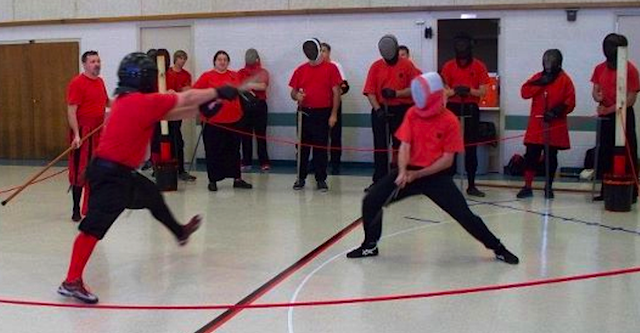 Fighting
men of the Renaissance were real people. They existed in a real world
and they had their own hopes and fears; their own dreams and aspirations.
They dealt with their own troubles and complexities of daily life. They
had their own norms and mores, morals and beliefs. Unlike ours today,
they lived in an honor culture and far more than we are now they were
inured to acts of personal and public violence. It's not possible
then, or even proper, I would argue, to try to view their arms and armor
as mere artifacts in isolation from all this. Nor is it ideal to view
their self-defense methods as mere skills separate and independent from
the larger social context that spawned them --in other words, the culture
of Renaissance martial arts. Fighting
men of the Renaissance were real people. They existed in a real world
and they had their own hopes and fears; their own dreams and aspirations.
They dealt with their own troubles and complexities of daily life. They
had their own norms and mores, morals and beliefs. Unlike ours today,
they lived in an honor culture and far more than we are now they were
inured to acts of personal and public violence. It's not possible
then, or even proper, I would argue, to try to view their arms and armor
as mere artifacts in isolation from all this. Nor is it ideal to view
their self-defense methods as mere skills separate and independent from
the larger social context that spawned them --in other words, the culture
of Renaissance martial arts.
Looking ahead by looking back
When I was younger, I use to view people who practiced certain Asian
martial art styles in the West --that is, Westerners who were following
some brand of some particular tradition --and very often it seemed to
me to be a bit pretentious. It came across as a form of escapism and role-play
in the way they would get so deep into how ideally each martial culture
was presented. After all, as I'd remind them on occasion, they were not
15th-century Okinawans, nor 10th-century Chinese monks, nor 16th-century
feudal Japanese soldiers, let alone masked "assassins." They
were 20th-century Western citizens born and raised under entirely different
cultures and circumstances. "You live in a very different world and
come from a very different background and conditions," I would say.
Sometimes they would consider my point; other times, my reasoning seemed
to attack their very self-identity.
 At
the opposite end of the spectrum, other martial artists I encountered
in the past would say to me, "Oh, I just like to practice fighting," and,
"I really just enjoy sparring and exercising." Or else they might tell
me they "just like learning" about whatever historical theory of ethnographic
self-defense they'd been exposed to. Over time, however, as I began to
delve more deeply into my own subject, Medieval and Renaissance combat
skills, I began to realize more and more that to study it, to research
and explore it, to recover and revive it, something more profound was
occurring than just "learning historical fighting." At
the opposite end of the spectrum, other martial artists I encountered
in the past would say to me, "Oh, I just like to practice fighting," and,
"I really just enjoy sparring and exercising." Or else they might tell
me they "just like learning" about whatever historical theory of ethnographic
self-defense they'd been exposed to. Over time, however, as I began to
delve more deeply into my own subject, Medieval and Renaissance combat
skills, I began to realize more and more that to study it, to research
and explore it, to recover and revive it, something more profound was
occurring than just "learning historical fighting."
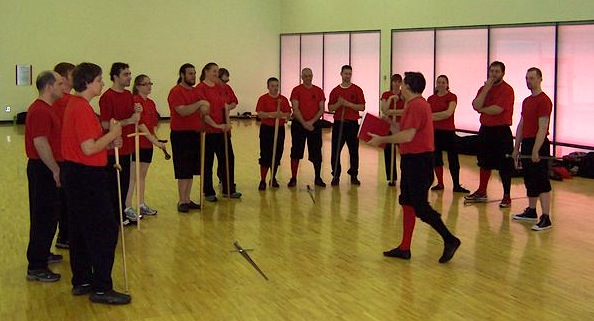 Though
our milieu today is hardly that of Medieval and Renaissance Europe, I
came to the understanding that it's not possible to authentically redevelop
historical combative systems without learning something about why
peoples in the past did them (not just how). Why they were willing
to fight or duel, why they went about armed, and why they were (frequently)
willing to take life or risk their own, all came to the forefront for
me. I found myself asking more and more what their philosophy and views
were to these things and why these beliefs became to be. Though
our milieu today is hardly that of Medieval and Renaissance Europe, I
came to the understanding that it's not possible to authentically redevelop
historical combative systems without learning something about why
peoples in the past did them (not just how). Why they were willing
to fight or duel, why they went about armed, and why they were (frequently)
willing to take life or risk their own, all came to the forefront for
me. I found myself asking more and more what their philosophy and views
were to these things and why these beliefs became to be.
I don't think it's possible to investigate and explore, nor interpret,
the historical sources of our craft without trying to understand why these
men developed these skills, why they saw the necessity for self-defense,
and why they would act on it. For as you dig deeper to find within the
source teachings material that addresses the psychological elements --the
emotional and mental aspects --as well as the ethical (and even spiritual)
components of the craft, it cannot help but give pause to meditate. For
myself, if I'm going to learn and practice their craft, then in the course
of my studies contemplation of this larger Renaissance martial culture
is unavoidable --even though I am neither a 14th-century Swabian, a 15th-century
Burgundian, a 16th-century Florentine, a 17th-century Spaniard, or what
have you (...and I've no interest in pretending I am one).
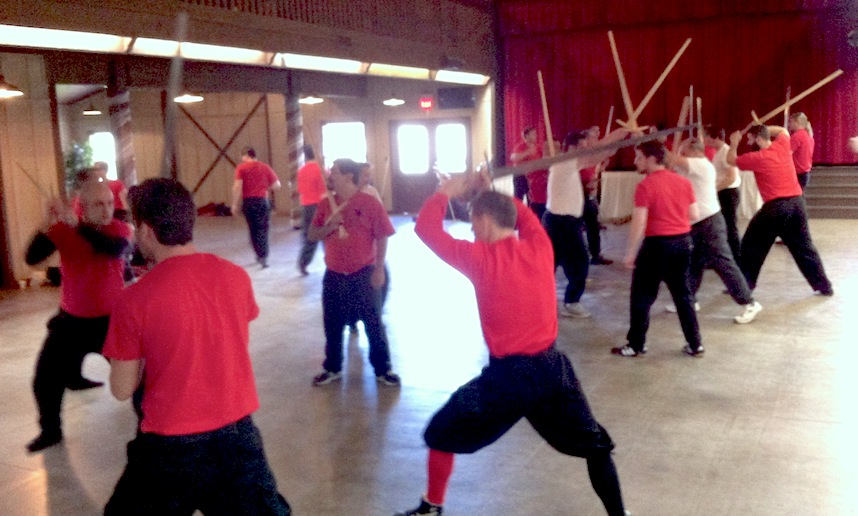 I
have seen the greatest satisfaction for students of this subject be found
in their discovering the value of applying lessons from the historical
teachings to their own lives. This is why the model I follow in my studies
can only be that of the aspirations of the historical masters and the
fighting guilds themselves, for they are the ones who wrote the teachings
and upheld the virtues of this craft. The serious student of the Science
of Defence ends up having to study knighthood, chivalry, medieval
Christianity, Latin, and the code duello, along with the art, literature,
and military science of the Age. In the course of this, you become more
involved in the material, such that, training in and reacquiring these
forgotten skills cannot but have an influence upon you --and, as I believe,
a positive impact on your life and values. I
have seen the greatest satisfaction for students of this subject be found
in their discovering the value of applying lessons from the historical
teachings to their own lives. This is why the model I follow in my studies
can only be that of the aspirations of the historical masters and the
fighting guilds themselves, for they are the ones who wrote the teachings
and upheld the virtues of this craft. The serious student of the Science
of Defence ends up having to study knighthood, chivalry, medieval
Christianity, Latin, and the code duello, along with the art, literature,
and military science of the Age. In the course of this, you become more
involved in the material, such that, training in and reacquiring these
forgotten skills cannot but have an influence upon you --and, as I believe,
a positive impact on your life and values.
As you become better educated in the lives and works of the fighting
men who made up Renaissance martial culture, appreciate their experiences
and heeds their words, you can identify with them and relate them to your
life today in the same way that these people dealt with adversity as they
strove themselves to be better and wiser. The fact that they had such
ideals in such a violent and brutal age --even if they didn't often meet
those aspirations --says a lot. You can take these things to heart and
aspire to them in a manner that is not pretend role-play or escapist costumed
fantasy and attempt to apply them now for the better.
 Modern
Eyes vs. Historical Context Modern
Eyes vs. Historical Context
Renaissance martial arts teachings represent a coherent systematic content
employing recognized fighting principles and concepts applicable to all
combat situations. Their codified methodological approach is self-evident
and undeniable from the sophistication and depth of their writings and
illustrations as well as what we now know in general of human combatives.
But did they develop and practice this diverse science and art of fighting
in a vacuum, free from any concern for the why, when, or where they were
to be used, let alone oblivious to what affect they might have upon the
learner? No. They did not. (Nor did they ascribe metaphysical sources
to their sled-defense methods.)
So, when someone says to me today, "I don't care, I just want to practice,"
or, "I just like to fight" and they try to make it a mock-combat sporting
game, well then, they are now doing something the historical masters and
students never did. The rebuttal to this argument is, "Yes, but back then
they did something we can't; they actually fought and killed." Irrelevant.
Not every fighting man in the Medieval or Renaissance world had slain
someone nor did they eventually die in battle or duel. We can surmise
many never even had occasion to defend their lives from actual threat
of personal violence. These things may have been the cause of needing
fighting arts in the first place but they were not a necessity
to learning the Science of Defence. There is the idea that someone today
can say, "I'm interested in historical combat and weapons and armor and
I want to know something about how they were used; it's fun to spar with
people, so that's what it's all about for me, getting that excitement,
that exercise, that challenge..." Well, then, hooray; good for you. Knock
yourself out... but good luck finding historical sources in this craft
to support or celebrate that perspective.
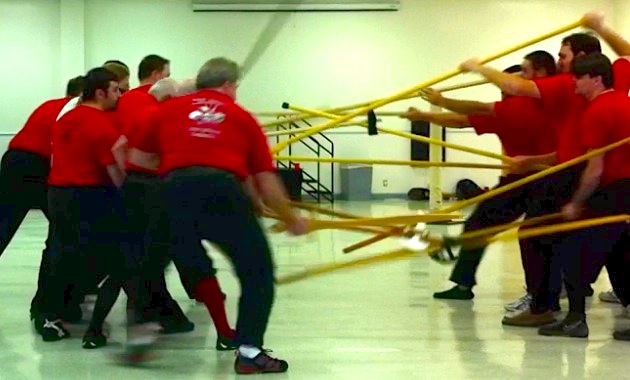 As
someone who had been doing the very thing above since he was a child and
who now as an adult is doing it professionally, my view is different.
It cannot help but be different. Because to me, being as deep as I am
into this subject, I see more within it and it has had a more profound
effect on me and my life. Such that I ask, how did they come up with these
skills, why did they pursue these methods, what was the nature of their
lives, their society, and their culture over this period of time such
that these things came to exist? Where did they go? Why did they disappear?
What changed? It wasn't just about the advent of new military technologies. As
someone who had been doing the very thing above since he was a child and
who now as an adult is doing it professionally, my view is different.
It cannot help but be different. Because to me, being as deep as I am
into this subject, I see more within it and it has had a more profound
effect on me and my life. Such that I ask, how did they come up with these
skills, why did they pursue these methods, what was the nature of their
lives, their society, and their culture over this period of time such
that these things came to exist? Where did they go? Why did they disappear?
What changed? It wasn't just about the advent of new military technologies.
So, for me the subject becomes a cultural matter. It turns into a study
of Renaissance martial culture, and not artifacts and objects nor literature
and images. It goes beyond the effort to replicate the physicality of
how they manipulated their tools and handled themselves in fights. It
is by exploring past this that makes this a richer subject than you may
have suspected. And it certainly transcends trivial mock-combat contests
and costumed pretending.
The "Lone Warrior" Myth - Martial Brotherhoods as Comrades
in Arms
We can note that, historically, the guilds and masters protected the
privilege of earning rank through the integrity of a unified curriculum
and by choosing whom to teach and whom not to teach. They even garnered
prestige as urban militias by this. They were never concerned with "just
about fighting" and "just wanting to be fighters." The
Germanic schools for this very reason were known as "brotherhoods"
after all. Study in a Renaissance school of defense or under a master
of arms could not have been anything other than a commitment to work with
teachers and fellows within their program and to uphold the integrity
of their community's values as a fraternity of arms.
There is no disputing that individual aspiration to achieve skill and
earn rank in the schools of defence was ever present. This is a feature
of our Western martial heritage extending back to the citizen soldiers
of Greece. After all, the very essence of both chivalric knighthood and
being a courtier of distinction was to stand out as an individual of
accomplishment, renown, and valor. And for the fighting man, achievement
always required expert tutoring to harness their own aptitude and
initiative. But again, context is everything. For warriors, solidarity
within a genuine community is a matter of accepted standards and values
among local companions as well as one's kith and kin. The patronage that
masters often received from wealthy nobles and the teamwork undoubtedly
at work among the guilds can each be viewed as examples of this.
 Knights
and cavaliers were never really wandering "lone warriors" just "doing
their own things." Even knights-errant acted in the context of the feudal
system, in relation to their own lord and family, as well as (especially)
the church. While their own personal, political, and economic interests
were certainly forefront the majority of the time, we cannot view them
in isolation as merely an individual selfishly seeking his own prowess
and valor. Nor can we view the Renaissance courtier as someone concerned
exclusively with his own sense of honor and personal renown, because this
identity was itself something that existed within his own community of
peers and social class in the context of what expectations or pretensions
he had toward being a gentleman. These things were directly connected
to how he related to others and how he was perceived by others and not
simply a matter of his own pride or gratification. Renaissance courtiers
with regard to the code of dueling were concerned with behavior and how
the individual might make better service of himself to his prince or his
family or his king. It wasn't just about having "cred" to prevent others
from "dissing" you because you're a street "tough." It wasn't merely about
avoiding vendetta and earning some "rep." Prowess was developed for self-defense,
military service, and vindication of personal honor, yes, but this had
to do with the fighting man's larger community, not just his own person. Knights
and cavaliers were never really wandering "lone warriors" just "doing
their own things." Even knights-errant acted in the context of the feudal
system, in relation to their own lord and family, as well as (especially)
the church. While their own personal, political, and economic interests
were certainly forefront the majority of the time, we cannot view them
in isolation as merely an individual selfishly seeking his own prowess
and valor. Nor can we view the Renaissance courtier as someone concerned
exclusively with his own sense of honor and personal renown, because this
identity was itself something that existed within his own community of
peers and social class in the context of what expectations or pretensions
he had toward being a gentleman. These things were directly connected
to how he related to others and how he was perceived by others and not
simply a matter of his own pride or gratification. Renaissance courtiers
with regard to the code of dueling were concerned with behavior and how
the individual might make better service of himself to his prince or his
family or his king. It wasn't just about having "cred" to prevent others
from "dissing" you because you're a street "tough." It wasn't merely about
avoiding vendetta and earning some "rep." Prowess was developed for self-defense,
military service, and vindication of personal honor, yes, but this had
to do with the fighting man's larger community, not just his own person.
 In
countless military schools and fighting styles throughout history, conditions
were placed upon instruction and participation whereby students were asked
to uphold pledges regarding the virtues of the craft and respect their
teachers and comrades in arms. This occurred not through mere exercising
together or engaging in mock-combat rituals, but through shared standards
and a shared sense of personal honor, loyalty, and brotherhood. It wasn't
a matter of idealism; it was just pragmatism. There is no question much
of this was concerned with controlling violence and violent impulses among
the armed classes for very practical societal reasons. But it surely served
another purpose as well. The old guilds and masters of Europe readily
understood what every serious mature martial artist comes to know: that
the physical, emotional, mental, and moral are inseparable in becoming
the best possible fighter you can. In
countless military schools and fighting styles throughout history, conditions
were placed upon instruction and participation whereby students were asked
to uphold pledges regarding the virtues of the craft and respect their
teachers and comrades in arms. This occurred not through mere exercising
together or engaging in mock-combat rituals, but through shared standards
and a shared sense of personal honor, loyalty, and brotherhood. It wasn't
a matter of idealism; it was just pragmatism. There is no question much
of this was concerned with controlling violence and violent impulses among
the armed classes for very practical societal reasons. But it surely served
another purpose as well. The old guilds and masters of Europe readily
understood what every serious mature martial artist comes to know: that
the physical, emotional, mental, and moral are inseparable in becoming
the best possible fighter you can.
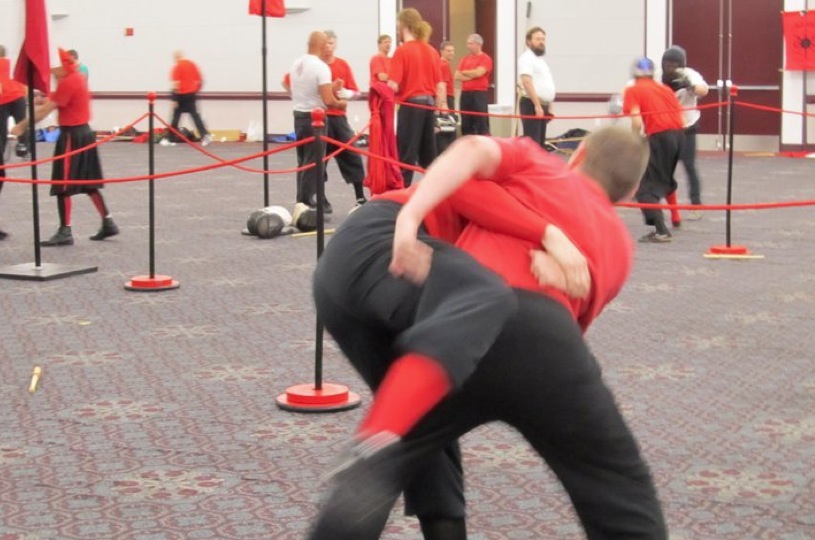 It
is a certainty that ultimately, prowess is closely linked to how, where,
why, and with whom you train. This sentiment is found throughout Medieval
chivalric tales and the rich instructional literature of our chosen subject.
The individual fighting man seeks skill in self defense, yes, but
he does so within a social framework that defines who he is and why he
fights. The Renaissance fighting man was always an individual who did
not suppress either his sense of self or personal honor. Yet, the notion
that one was a "lone warrior" is seemingly absent in the Age. It
is a certainty that ultimately, prowess is closely linked to how, where,
why, and with whom you train. This sentiment is found throughout Medieval
chivalric tales and the rich instructional literature of our chosen subject.
The individual fighting man seeks skill in self defense, yes, but
he does so within a social framework that defines who he is and why he
fights. The Renaissance fighting man was always an individual who did
not suppress either his sense of self or personal honor. Yet, the notion
that one was a "lone warrior" is seemingly absent in the Age.
Even when we consider the individual training that a knight or man-at-arms
might seek out as preparation for a judicial duel, which was an ordeal
of trial by combat within both a religious and legal context, the master
of defense did not simply coach the combatant in fighting skills. The
evidence from 15th century sources supports the reasonable understanding
that he also mentored the fighter psychologically. By the 16th century,
writings of masters operating their own schools and classes reflect that
they regularly addressed the role of values and character in what they
offered. The statements filling their treatises were no mere platitudes,
but served a practical function that we can surmise easily enough --to
prevent potential future threats to themselves and their students, to
dissuade claims of negligence, to assure civil authorities about their
peaceful intentions, and to discourage possible rivalries to their livelihood.
 Were
there mercenaries throughout the period? Were there hired swords plying
their craft or teaching their trade to whomever? Absolutely. Were there
were street-fights, ambushes, armed murders, gang battles, clan feuds,
and turf wars galore? Of course. And as well, there was constant banditry,
ignorant fanaticism, and brutal zealotry. But do we take these things
on as our role models today? Hardly. We look to better examples. Were
there feckless thugs, unscrupulous fops, and cowardly bullies thought
the period? Most certainly. But the historical source works do not celebrate
such individuals. Rather, they go out of the way to counsel the practitioner
of the craft against either inducing or falling for provocations to fight
for matters of no real concern. Were
there mercenaries throughout the period? Were there hired swords plying
their craft or teaching their trade to whomever? Absolutely. Were there
were street-fights, ambushes, armed murders, gang battles, clan feuds,
and turf wars galore? Of course. And as well, there was constant banditry,
ignorant fanaticism, and brutal zealotry. But do we take these things
on as our role models today? Hardly. We look to better examples. Were
there feckless thugs, unscrupulous fops, and cowardly bullies thought
the period? Most certainly. But the historical source works do not celebrate
such individuals. Rather, they go out of the way to counsel the practitioner
of the craft against either inducing or falling for provocations to fight
for matters of no real concern.
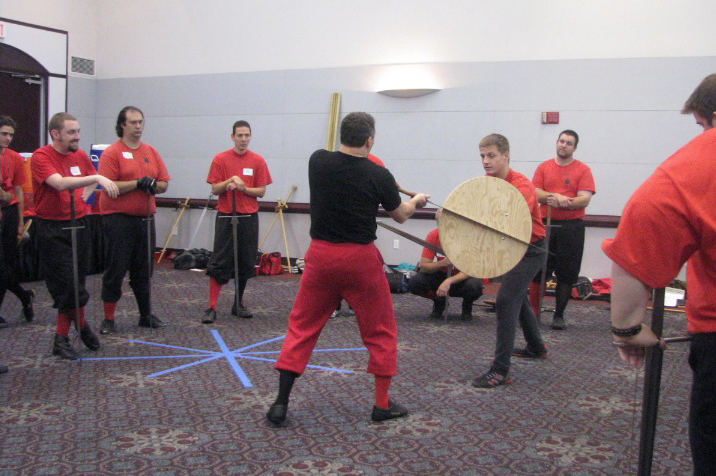 We
can also note with curiosity how the few surviving images of schools and
practices featuring figures training at arms proudly celebrate their emblems
and names, while the various treatises and works of single masters celebrate
the Art itself more than they do the teacher or author. When we
read of the 16th century London company of masters referring to their
affiliated schools and teachers traveling from leagues around the city
to attend Prizings, and how the participants in these were the students
and members of their various branches, we understand that they were all
party to a unified guild with its established rules and order. Each chapter
of their guild was equal and independent, yet connected to one another
by more than just mutual interests. We
can also note with curiosity how the few surviving images of schools and
practices featuring figures training at arms proudly celebrate their emblems
and names, while the various treatises and works of single masters celebrate
the Art itself more than they do the teacher or author. When we
read of the 16th century London company of masters referring to their
affiliated schools and teachers traveling from leagues around the city
to attend Prizings, and how the participants in these were the students
and members of their various branches, we understand that they were all
party to a unified guild with its established rules and order. Each chapter
of their guild was equal and independent, yet connected to one another
by more than just mutual interests.
Something similar went
on with guilds and schools in Germany, Italy, and Spain, where the attendees
at such tests were not just anyone off the street who signed up, but those
who were admitted because of their character and their acceptance of a
certain code of values. We don't know the details of what these were,
but we do know they existed and we have hints as to what they must have
involved. In the same way, a knight would not just ride up to a tournament
and enter the list. Rather, he had to prove his lineage, his nobility,
had to be established at a court, or have a have sponsors vouch for him.
He had to have previously proven his worthiness through squireship or
by acts of valor, as well as having earned something of a name or reputation
by his actions. Only in fiction is there any "mysterious wandering
loner." Today we might easily say, "to each their own."
Sure. Whatever. But to respect the historical sources, to emulate their
model, and to honor our martial heritage, I think we owe it to aspire
to something more.
Self-Defense or Defending Selfishness?
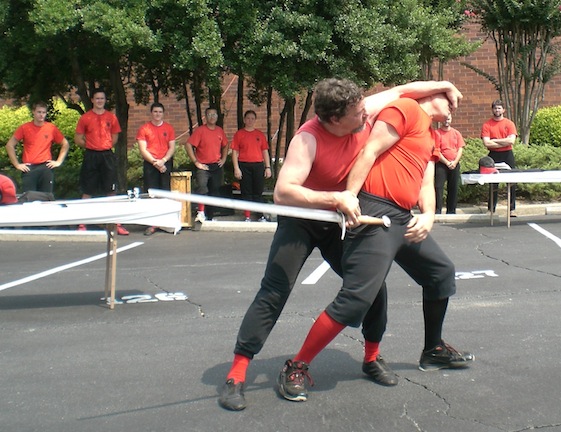 The
study of martial arts is ultimately a quest for self-knowledge. As you
learn about the action and reaction of the human body and human mind under
the stress of personal combat, you also learn about yourself. The idea
that combative training may consist of more than just the physical and
emotional aspects is part of the Art. Otherwise, what you have learned
is merely fighting moves and fighting principles. Ultimately, these fade
and the fighter is left only with memories of actions they could once
perform. The
study of martial arts is ultimately a quest for self-knowledge. As you
learn about the action and reaction of the human body and human mind under
the stress of personal combat, you also learn about yourself. The idea
that combative training may consist of more than just the physical and
emotional aspects is part of the Art. Otherwise, what you have learned
is merely fighting moves and fighting principles. Ultimately, these fade
and the fighter is left only with memories of actions they could once
perform.
In his treatise of 1531, the master Antonio Manciolino reacted to what
he saw as the constant associating of common fencers with low-lifes and
the underbelly of society as exemplified by inferior commercial schools
and teachers: "...in my opinion things are placed into the school
only for their profit, and not that of others. Hundreds are their chapters,
for in them is contained nothing other than the putting of a price on
the masterful play of this art, as the virtue of arms has fallen to such
baseness that it is wished by them to find her holy members sold at a
price through the schools, boasting, without consideration that the dull
and the subtle wits can not equally bear this yoke upon their shoulders,
and that the art is not a harlot to suffer itself to be sold." It
wasn't mere commercialization that Manciolino was lamenting, but the teaching
of the Art without the proper knightly values and the honor in a brotherhood
of arms.
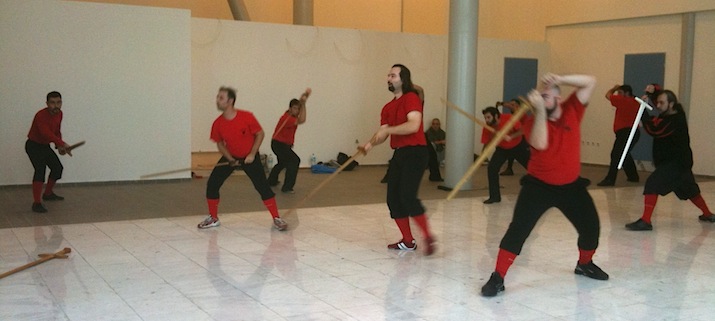 I
can relate to master Manciolino's lament. I used to believe that, ultimately,
martial arts were indeed "selfish..." That is, they were self-centered;
they were only about the self, about your skill and your ability and your
prowess and you challenging yourself to be better than you are. Such that,
ultimately, this is an entirely self-centered and even selfish thing.
In the past, I had conversations with veteran professional martial arts
instructors who would say to me, yeah this is true. By contrast, others
would say, oh no, absolutely not. As I got deeper into studying the warrior
code in relation to Western civilization and Renaissance martial culture,
I've come to realize that they are in fact not self-centered nor selfish.
Though you are learning to defend yourself, you are still doing it within
the context of protecting your family, your loved ones, your community,
your nation, and your beliefs and values, and do so within your identity
as a warrior. This gives you cause to accept a certain definition of who
is and who is not a combatant. It addresses when and where and why it
is appropriate to use force. These are issues that are not selfish. They
exist only within whatever social context and values that you as a "warrior"
accept. I
can relate to master Manciolino's lament. I used to believe that, ultimately,
martial arts were indeed "selfish..." That is, they were self-centered;
they were only about the self, about your skill and your ability and your
prowess and you challenging yourself to be better than you are. Such that,
ultimately, this is an entirely self-centered and even selfish thing.
In the past, I had conversations with veteran professional martial arts
instructors who would say to me, yeah this is true. By contrast, others
would say, oh no, absolutely not. As I got deeper into studying the warrior
code in relation to Western civilization and Renaissance martial culture,
I've come to realize that they are in fact not self-centered nor selfish.
Though you are learning to defend yourself, you are still doing it within
the context of protecting your family, your loved ones, your community,
your nation, and your beliefs and values, and do so within your identity
as a warrior. This gives you cause to accept a certain definition of who
is and who is not a combatant. It addresses when and where and why it
is appropriate to use force. These are issues that are not selfish. They
exist only within whatever social context and values that you as a "warrior"
accept.
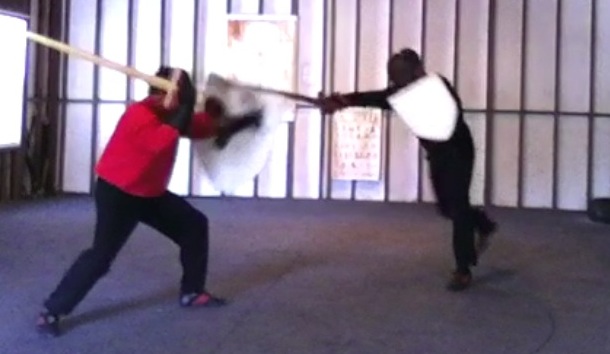 So,
am I contending here that every knight or man at arms or cavalier or courtier
at the time was aware of these matters and concerned with these kinds
of things? No. Absolutely not. But, I am saying that when we read the
literature of the age dealing with chivalry, honor, or martial arts, and
when we consider the social, theological, and philosophical forces at
work in Renaissance martial culture, then yes, we do see that they are
concerned with something more than just self-defense. When we find in
the source teachings not just fighting instructions but other material
addressing such matters, it is impossible to ignore. We see that they
were concerned with something more than just technical aspects of "self-defense."
The writings that often precede and introduce their combat methods or
that close and conclude their lessons contain a wealth of material. They
address and consider issues that often define why one attains these skills
and who they are intended for, not just what they are. So,
am I contending here that every knight or man at arms or cavalier or courtier
at the time was aware of these matters and concerned with these kinds
of things? No. Absolutely not. But, I am saying that when we read the
literature of the age dealing with chivalry, honor, or martial arts, and
when we consider the social, theological, and philosophical forces at
work in Renaissance martial culture, then yes, we do see that they are
concerned with something more than just self-defense. When we find in
the source teachings not just fighting instructions but other material
addressing such matters, it is impossible to ignore. We see that they
were concerned with something more than just technical aspects of "self-defense."
The writings that often precede and introduce their combat methods or
that close and conclude their lessons contain a wealth of material. They
address and consider issues that often define why one attains these skills
and who they are intended for, not just what they are.
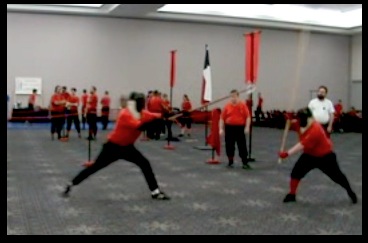 In
my effort to learn about and revive these forgotten fighting methods,
I have come to focus on many varied aspects of the subject, from arms
and armor to wounds and injuries, from warfare and dueling to the ethical
and spiritual component, and from the social to the legal. It is nothing
short of the whole of Renaissance martial culture. In doing so,
I cannot help but contemplate upon the many intangibles first expressed
in the teachings attributed to the 15th century grand fight master, Johannes
Liechtenauer. A range of statements are attributed to him regarding the
qualities necessary to a skillful fighter or master. These consist of
knowledge, courage, prudence, cunning and wisdom. These qualities are
repeated in the introduction to almost every section of his teachings.
He further mentions secrecy, reason, determination or deliberateness,
and readiness as being important among these attributes. Besides physical
elements, these are factors permitting one to perform actions without
being hindered by your psyche: "your swordsmanship should go with good
courage and good mind or reason, and with no fear." Master Liechtenauer
stressed mental focus and made significant mention of subtle mental and
emotional elements involved in fighting: "Whatever you want to perform,
you should remain in good reason," he declared, adding that in real combat
or in practice, you should be in a "good spirit" so that you can pay attention
to and perform techniques with "good courage and quickness against the
enemy." "That is because a good spirit with strength makes [the opponent's]
resistance doubtful-that is why I advise you, do not undertake any tricks,
avoid fury." And tellingly, he cautioned the fighter to "Be modest in
your over-confidence." Indeed... and this was from a knight recognized
as a master and a teacher. In
my effort to learn about and revive these forgotten fighting methods,
I have come to focus on many varied aspects of the subject, from arms
and armor to wounds and injuries, from warfare and dueling to the ethical
and spiritual component, and from the social to the legal. It is nothing
short of the whole of Renaissance martial culture. In doing so,
I cannot help but contemplate upon the many intangibles first expressed
in the teachings attributed to the 15th century grand fight master, Johannes
Liechtenauer. A range of statements are attributed to him regarding the
qualities necessary to a skillful fighter or master. These consist of
knowledge, courage, prudence, cunning and wisdom. These qualities are
repeated in the introduction to almost every section of his teachings.
He further mentions secrecy, reason, determination or deliberateness,
and readiness as being important among these attributes. Besides physical
elements, these are factors permitting one to perform actions without
being hindered by your psyche: "your swordsmanship should go with good
courage and good mind or reason, and with no fear." Master Liechtenauer
stressed mental focus and made significant mention of subtle mental and
emotional elements involved in fighting: "Whatever you want to perform,
you should remain in good reason," he declared, adding that in real combat
or in practice, you should be in a "good spirit" so that you can pay attention
to and perform techniques with "good courage and quickness against the
enemy." "That is because a good spirit with strength makes [the opponent's]
resistance doubtful-that is why I advise you, do not undertake any tricks,
avoid fury." And tellingly, he cautioned the fighter to "Be modest in
your over-confidence." Indeed... and this was from a knight recognized
as a master and a teacher.
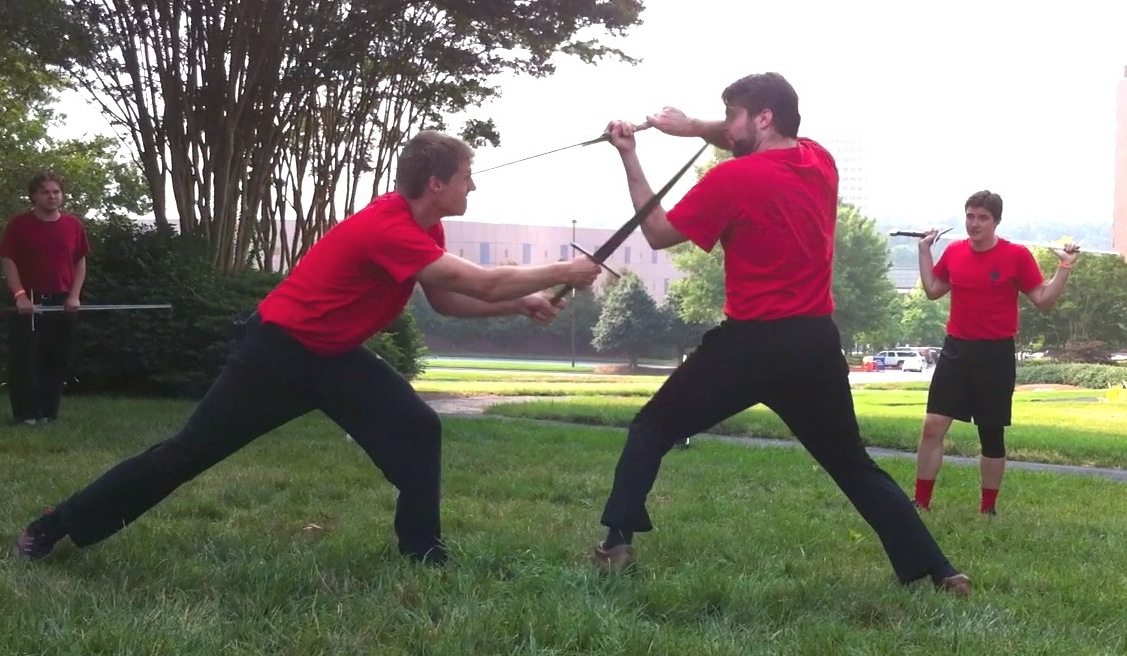 Today,
as I study the source teachings, train in and teach their concepts and
techniques, explore their self-defense skills and investigate their fighting
methods, I cannot help but do so with awareness of the society and environment
under which it blossomed. I can't teach it without some regard for this.
Thus, what I advocate in pursuit of this craft is that, beyond its legitimate
self-defense content, it can again be something more than just a recreational
sport or hobby or escapist amusement. I contend that like any true martial
art, beyond mere combative skill, it helps improve the individual and
reveal character by supporting your self-discipline and thereby helps
make you a better person if you allow it. This is nothing less than the
ideal purpose of martial culture in the Renaissance. The humanist educators
of the age (some of whom were themselves masters of arms) even envisioned
martial arts training as specifically serving this purpose. Today,
as I study the source teachings, train in and teach their concepts and
techniques, explore their self-defense skills and investigate their fighting
methods, I cannot help but do so with awareness of the society and environment
under which it blossomed. I can't teach it without some regard for this.
Thus, what I advocate in pursuit of this craft is that, beyond its legitimate
self-defense content, it can again be something more than just a recreational
sport or hobby or escapist amusement. I contend that like any true martial
art, beyond mere combative skill, it helps improve the individual and
reveal character by supporting your self-discipline and thereby helps
make you a better person if you allow it. This is nothing less than the
ideal purpose of martial culture in the Renaissance. The humanist educators
of the age (some of whom were themselves masters of arms) even envisioned
martial arts training as specifically serving this purpose.
Being a part of the old fighting guilds and studying under a master in
a Fechtschule was about much more than having the martial spirit
and physical conditioning to skillfully execute techniques. It was also
about shared values and issues of camaraderie, mutual respect, trust,
and loyalty. It's all but impossible to argue it was anything otherwise.
Experiencing aspects of this martial culture is as much a part of exploring
and celebrating our Renaissance martial heritage as is learning fighting
techniques. It is in my view no less an aspect to revive than the skills
themselves. It enriches and promotes appreciation of our craft. How could
it not be?
Arms Do Not Make the Man
Because weapons tended to sully those who used them, among the ancient Romans the individual use of force (virtus) was seen to necessarily had to be balanced with character (ingenium).
This idea, carried over from the Greeks, was to influence both the code
of Medieval chivalry and the civility of Renaissance courtiers.
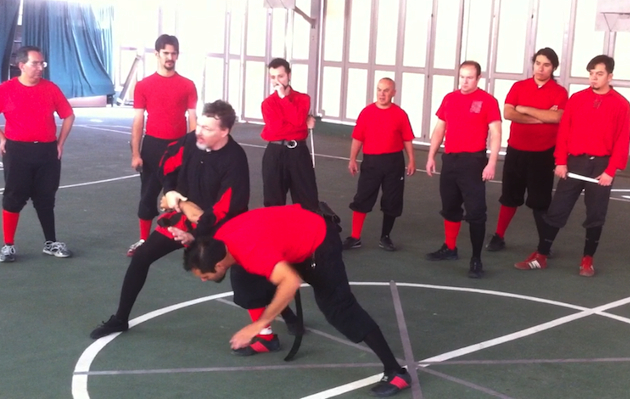 If
you're practicing a fighting method and all it's ultimately about for
you is fighting and killing others, and you're not practicing it with
the frame of mind of when and where it would be appropriate to use it,
then you're not giving any context to the very meaning of everything
you're doing. And it will eventually reflect in your skills. You cannot
simply say, “Oh, it's about self-defense,” because self-defense can
always be twisted (and historically has) into being “self-offense” --in
other words, “it's okay for me to attack and kill anyone who I deem to
be worthless or a threat.” Thus, determining what is appropriate and
inappropriate violence lies at the very heart of practicing Renaissance
martial arts. It is the ethical component at the very center of the
craft. You cannot escape this without reducing the Art to indifferent
fighting techniques devoid of any moral constraint (e.g., “I just like
fighting”). This was something not expressed in the Schools of Defence
nor in the teachings of the Masters. This warrior ethic may be
culturally subjective, certainly, but it still has its origin in
maintenance of a healthy society. If
you're practicing a fighting method and all it's ultimately about for
you is fighting and killing others, and you're not practicing it with
the frame of mind of when and where it would be appropriate to use it,
then you're not giving any context to the very meaning of everything
you're doing. And it will eventually reflect in your skills. You cannot
simply say, “Oh, it's about self-defense,” because self-defense can
always be twisted (and historically has) into being “self-offense” --in
other words, “it's okay for me to attack and kill anyone who I deem to
be worthless or a threat.” Thus, determining what is appropriate and
inappropriate violence lies at the very heart of practicing Renaissance
martial arts. It is the ethical component at the very center of the
craft. You cannot escape this without reducing the Art to indifferent
fighting techniques devoid of any moral constraint (e.g., “I just like
fighting”). This was something not expressed in the Schools of Defence
nor in the teachings of the Masters. This warrior ethic may be
culturally subjective, certainly, but it still has its origin in
maintenance of a healthy society.
The notion that you can be this “warrior loner” concerned only with
“perfecting his craft” independent of larger society is nonsense. The
community in which you live ultimately defines your role as a warrior or
fighting man. This manifests in the recognition that study of martial
discipline goes beyond pure survival, to the protection of your loved
ones, your community, and your civilization, such that the study of arms
and combat skills is inseparable from why you would use them.
Regardless of whether its function is centered on personal self-defense,
the craft was not devised for hermits, isolated monks, or barbarians.
It was meant to be used in honor by tempering our natural tendencies
toward predation and aggression. The point of the craft possessing such
values has ever been to polish the more savage side of our psyche. Aside
from whether the effort often failed historically, as students we
should ever strive toward that ideal.
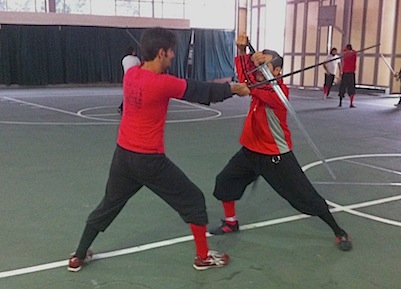 If you're practicing a fighting method and all that it is ultimately
about for you is fighting and killing others, and you're not practicing
it with the frame of mind of when and where and why it could be
appropriate to use it, then you're not giving any context to the very
meaning of everything you're doing. A fighting art is not just about
fighting skills. You cannot simply say, "Oh, it's all self-defense,"
because self-defense can always be twisted (and often has throughout
history) into being "self-offense" --in other words, "It's okay for me
to attack and kill anyone I deem to be worthless or a threat to
myself." Thus, determining what is appropriate and inappropriate
violence is at the very heart of practicing a martial art. It is the
ethical component at the center of the craft and our source works
regularly address the matter. You cannot escape it without reducing our
martial arts to simply indifferent fighting techniques devoid of any
moral conscience, e.g. "I just like fighting." That was not something
approved by the Schools of Defence or the teachings of the Masters. Such
an "ethical component" may be culturally subjective, certainly, but it
still has its origin in maintenance of a healthy society through the
responsible bearing of arms, not just focusing on individual survival.
There is ultimately then a bit of a dilemma for us today in this. How do
we on the one hand celebrate martial spirit and appreciate it with
sincerity without trivializing it into sport and self-deluding
role-play? How do you respect it's historic gravity and import when it
is no longer of everyday survival necessity? My own answer is that we
for sure don't achieve this by sportifying it, but rather by respecting
it's historical integrity. If you're practicing a fighting method and all that it is ultimately
about for you is fighting and killing others, and you're not practicing
it with the frame of mind of when and where and why it could be
appropriate to use it, then you're not giving any context to the very
meaning of everything you're doing. A fighting art is not just about
fighting skills. You cannot simply say, "Oh, it's all self-defense,"
because self-defense can always be twisted (and often has throughout
history) into being "self-offense" --in other words, "It's okay for me
to attack and kill anyone I deem to be worthless or a threat to
myself." Thus, determining what is appropriate and inappropriate
violence is at the very heart of practicing a martial art. It is the
ethical component at the center of the craft and our source works
regularly address the matter. You cannot escape it without reducing our
martial arts to simply indifferent fighting techniques devoid of any
moral conscience, e.g. "I just like fighting." That was not something
approved by the Schools of Defence or the teachings of the Masters. Such
an "ethical component" may be culturally subjective, certainly, but it
still has its origin in maintenance of a healthy society through the
responsible bearing of arms, not just focusing on individual survival.
There is ultimately then a bit of a dilemma for us today in this. How do
we on the one hand celebrate martial spirit and appreciate it with
sincerity without trivializing it into sport and self-deluding
role-play? How do you respect it's historic gravity and import when it
is no longer of everyday survival necessity? My own answer is that we
for sure don't achieve this by sportifying it, but rather by respecting
it's historical integrity.
It is not enough to be taught fighting skills me must be taught how to
act with those skills. This isn't acquired by oneself alone and isn't
learned in a cultural vacuum. In other words, study of the Art
requires it be defined by virtues --individual thoughts and actions that
reflect benevolence and excellence. Your study can't be isolated from
this.
August 2012
See
also:
Our Chosen Model and Example
|

